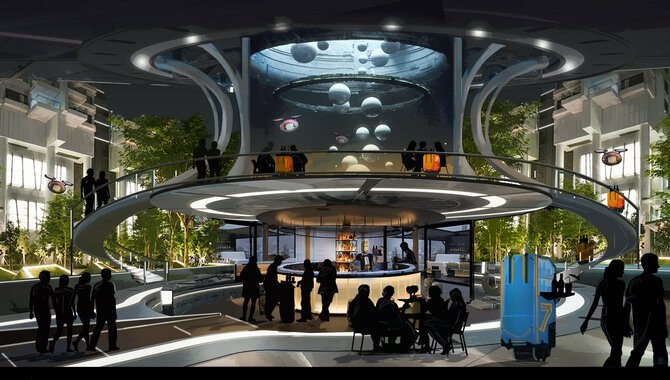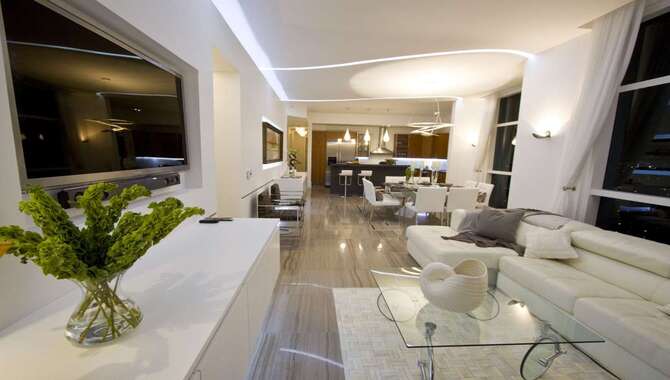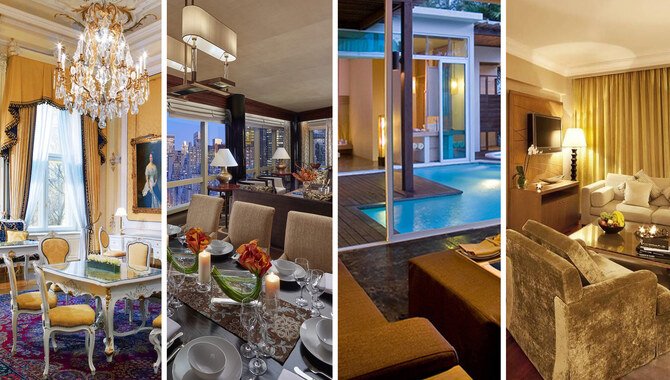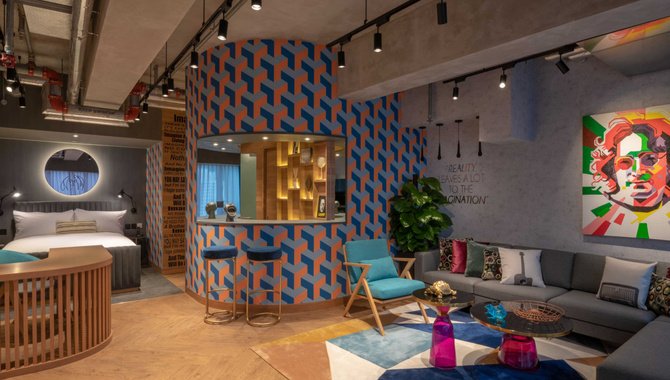The luxury hotel design and architecture industry is expanding at a fast pace. From top-class hotels to boutique hotels, everyone’s looking to have an ideal place to stay.
Every new hotel opening is strategic and aims to set new standards in customer experience. Often, it’s the design that attracts guests and defines the experience of staying there.
Designers today are working smarter, integrating art into their work for a better outcome. The way a hotel looks cannot only define its brand identity but also how guests perceive it.
In this guide, we’ll tell you everything you need to know about designing hotels and the most popular approaches being followed today in luxury hotels.

What Is Hotel Design In Architecture?

Hospitality design is focused on blending sustainability and modern technology to create a gateway to the city for visitors and guests.
Services provided by architects may include feasibility studies, programming and space planning, full-service architecture, and guestroom layout and interior design.
They can also create unique experiences through their creative work. A hotel’s interior can be a reflection of its own identity as well as that of its environment.
Exploring The Latest Trends In Luxury Hotel Design And Architecture

With the proliferation of luxury hotels and resorts, it is a matter of great interest to explore the latest trends in luxury hotel design. No matter how big or small your budget is, you can always find a range of luxurious hotels that suit your needs.
From contemporary architecture to bold colors, there are plenty of options to choose from. As per the latest trends, luxury hotel design has evolved into more diverse forms, including eco-friendly ones.
Some hotels have gone a step further and used innovative technologies like virtual reality to create an immersive experience for guests. With such innovative options available, you can be sure that your stay at a luxury hotel will be a memorable one.
Designing For Accessibility In Luxury Hotels

Creating a luxurious environment in a hotel can be a daunting task. But the right design can not only enhance the look and feel of the space, but it can also make guests feel welcome and pampered.
When designing for accessibility in luxury hotels, it is important to consider people with disabilities, such as those with mobility issues or visual impairments.
Consider how you can make your space more accessible to these groups, such as by using elevators that accommodate wheelchairs or by providing Braille menus or other materials in accessible formats.
It is also important to consider the physical environment of a hotel when designing for accessibility.
Elements Of Luxury Hotel Design

Luxury hotels are incorporating modern changes in their interiors and layouts to meet the demands of the new generation of travelers. Design trends focus on blending sustainability and modern technology to create unique hotel experiences for today’s travelers.
Many luxury hotels are embracing the art deco era and incorporating elements such as corrugated facades, hand-painted hothouse murals, and plaster work.
Historical design, architectural elements, and design hotels are becoming increasingly popular. These hotels aim to offer a unique experience to their guests, by combining the best of past and present design aesthetics.
Whether you’re traveling for business or pleasure, a luxury hotel is sure to provide you with a memorable stay.
Types Of Luxury Hotels

Luxury hotels are incorporating new design elements in their interiors, dining scenes, lobbies, guestrooms, bathrooms, and outdoor spaces to create striking and unique hotel experiences.
Whether it’s a contemporary lighting fixture or a stylish bathtub, many luxury hotels employ internationally renowned designers to create artistic flair and drama in the hotel.
In addition to their design features, many luxury hotels also pay tribute to the past by incorporating vintage pieces into their interiors.
These hotels often have specific design standards based on their brands, such as The Ritz-Carlton’s classic elegance or Rosewood’s modern sensibility.
The Role Of Architecture In Luxury Hotel Design

Luxury hotels are incorporating new design trends into their interiors and layouts to meet the expectations of their customers.
A deep understanding of the complex relationships between hotel owners and operators, front-of-house and back-of-house requirements, and the roles and responsibilities of the various players is essential to the success of the hotel.
High-profile design teams, such as Handel Architects, are creating eye-catching designs that draw on elements of nostalgia while also being modern and current.
Facades are a critical part of a hotel’s identity, with a range of styles, colors, shapes, and materials used to create a unique and memorable public face.
As with all types of businesses, luxury hotels need to ensure they stay relevant in a constantly changing market by taking advantage of new design trends and refining their offerings to meet changing customer demands.
Influence Of Global Trends On Luxury Hotel Design

The latest trends in luxury hotel design and architecture have been influenced by the changing demands of tourists.
Hotel designers, such as Kelly Wearstler, Pierre Yves Rochon, Alberto Pinto, Hirsch Bedner, and Yabu Pushelberg, are incorporating new elements into their designs to keep up with global trends.
Hotels are embracing sustainability and modern technology, and focusing on wellness and safety. For instance, hotels are using alternative energy sources to reduce their carbon footprint and promote sustainability.
They are also incorporating modern design elements like natural lighting or open-concept floor plans to create a more comfortable atmosphere. In addition, designer Jean-Michel Gathy predicts that 500-seat restaurants with buffets will soon be a thing of the past.
Instead, upscale restaurants will feature smaller menus with locally sourced ingredients. This will help hotels focus on quality over quantity when it comes to their food selection.
Elements Of Luxury Hotel Architecture

Architecture is an integral part of the overall experience at a luxury hotel, and it can make a difference in how welcoming the property feels.
One of the most important elements of architecture is the use of materials, and this can have a significant impact on how warm and inviting the building feels.
Materials also include lighting and color schemes, which affect how well a hotel blends in with its surroundings. Décor is another element that plays an important role in creating a luxurious atmosphere.
Finally, a luxury hotel should also have great design details, such as furniture that complements the space and floors that are designed to provide a smooth walking experience for guests. All these details come together to create an atmosphere that feels like a true sanctuary.
Combining Luxury Hotel Design And Architecture

Combining luxury and design in hotel architecture is increasingly popular with hotels incorporating new elements in their interiors and layouts to attract a new generation of tourists.
Recent design trends focus on blending sustainability and modern technology to create sustainable spaces that are both stylish and comfortable.
These spaces feature eco-friendly furnishings, high-tech lighting, and unique architectural details that help to create an immersive hotel experience.
Additionally, boutique hotels have incorporated modern design trends, such as The Dream Downtown Hotel in New York City. This hotel combines modern design with an old-world feel, giving it a unique identity while providing a luxurious stay.
The Benefits Of Art-Inspired Design For Luxury Hotels

You may have heard of the term ‘art deco’ when it comes to designing and decorating a home. Well, it is not just for décor. The art-inspired design has become quite an integral part of the luxury hotel industry.
The benefits of the art-inspired design are many, ranging from a more personal touch to provide a memorable experience for guests to the beauty of its architecture and interior design that makes every room feel like a work of art.
A modern aesthetic combined with rich textures and warm colors will transport you to another world as you take in the sweeping views or gaze up at the soaring ceilings. The use of art in luxury hotels also focuses on creating a sense of emotion and feeling within each space.
Whether it is through paintings or sculptures, incorporating artwork into your hotel can help bring a deeper meaning and connection to what may otherwise be just another place to stay.
How To Incorporate Sustainable Materials In Luxury Hotel Design
A growing number of hospitality designers are incorporating sustainable materials into their hotel designs, such as bamboo, fiber sheets, porcelain, and terracotta.
As environmental concerns intensify and new green building regulations come on board, hotels are focusing on blending sustainability and modern technology to incorporate eco-friendly practices and materials.
To incorporate sustainable materials in guest rooms and bathrooms, hospitality designers use low-flow shower heads, geothermal heat pumps, Energy Star lighting fixtures, solar panels, and natural or recycled materials.
They also conduct feasibility studies to determine the most appropriate amenities and programming for each room. In addition to these practices, hoteliers provide various services to incorporate sustainable materials into their luxury hotel designs.
Overall, hospitality designers are taking steps to incorporate sustainable materials into their designs to create more environmentally-friendly havens for travelers.
Conclusion
A hotel design can enhance a property’s overall appeal, ensuring it stands out in a crowded and competitive hospitality market. It can also help to create a unique and memorable experience for guests and boost occupancy rates.
And it’s not just the aesthetics of a design that influence how people feel about a property, but also its functionality, comfort, and the way it was created.
By understanding the design process behind Luxury hotel design and architecture, you can make better decisions concerning this field.
We discussed the benefits of luxury hotel design and architecture. We cover topics such as the importance of luxury hotel design, how luxury hotel design can improve customer experience, and the impact of luxury hotel design on tourism.
We hope you found this guide helpful and that it has inspired you to explore the world of luxury hotel design in more detail.
Frequently Asked Questions
Why Need To Know Best Hotel Designers?
The best hotel designers can also craft living and visual experiences that attract more customers and profits. This means designing extravagant spaces that include lush landscapes, striking architecture, and lush interior design.
In addition to providing a luxurious stay, top hotel designers are also responsible for ensuring the safety and security of their guests.
What Makes A Boutique Hotel Stand Out From The Rest?
A boutique hotel must incorporate a carefully crafted design that tells a strong story both inside and outside. This can include things like using natural materials and lighting, incorporating sustainability into the design, and using modern technology in the hotel’s facilities.
What Is The Best Hotel Design And Architecture?
For those with a penchant for opulence, the best hotel design and architecture is one that not only caters to the tastes of guests but also exudes class and style.
For those who are looking for a luxurious getaway, a good hotel design, and architecture will make sure that the experience is as comfortable and pleasurable as possible.
From the décor to the amenities, every aspect of the hotel should be well thought out and designed with maximum care.
How Do I Choose Between A Luxury Hotel And A Boutique Hotel?
When it comes to choosing between a luxury hotel and a boutique hotel, it is important to assess the amenities each offer.
Luxury hotels typically offer a range of facilities and services such as spas, pools, and fitness centers, while boutique hotels may offer more unique experiences like local cultural activities.
What Are Some Common Elements Of Luxury Hotel Architecture?
Some common elements of luxury hotel architecture include spa-like bathrooms, bay windows, and custom high-water jets.
To blend sustainability and modern technology into their design, many luxury hotels are incorporating sustainable materials and design principles into their structures and layouts.
